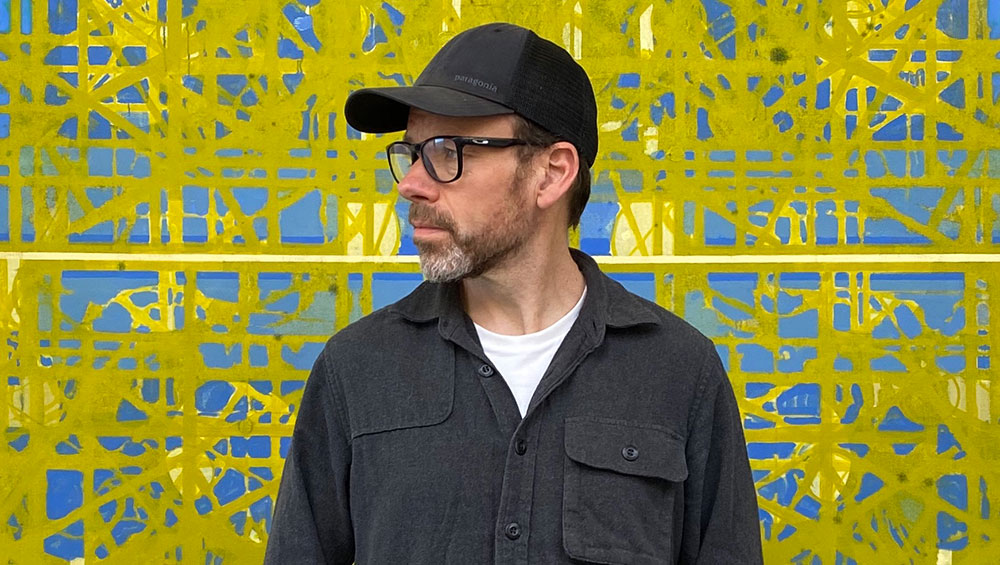
by ANNA McNAY
Matthew Burrows (b1971, the Wirral) is a painter through and through, even though his strategies for approaching his work include numerous analogies to try to free himself from the weight of art history. His canvases are built up with thin layers of paint, creating the effect of a textured piece, woven in and out, much like a basket. He likes to think of the horizontals and verticals as a play between a structure that is given and a process that is open.

Matthew Burrows. #ArtistSupportPledge tile. © Matthew Burrows.
Burrows is also the artist behind the enormously successful #ArtistSupportPledge, a simple idea, launched on Instagram just before lockdown in the UK, and now a worldwide phenomenon, earning many artists more than ever before, and proving to be self-sustaining for the community. Using the hashtag #ArtistSupportPledge, artists and makers post works for sale on social media, which must be £200 or under, with the implicit promise that, once they have sold £1,000 worth, they will buy a work by someone else, thus feeding back into the economy, creating a form of subsistence culture.

Matthew Burrows. Drawing included on #ArtistSupportPledge, from the In and Through Series, 2020. Ink on handmade paper, 26 x 21 cm. © Matthew Burrows.
Burrows studied as an undergraduate at Birmingham School of Art (1990-93) and graduated with a master’s degree in painting from the Royal College of Art in 1995. He lives and works in East Sussex, where the landscape, and his endurance runs through it, form an integral part of his practice.
Burrows spoke to Studio International about how the pledge came about, his hopes and plans for its future, his thinking about his practice, and how he hopes to return to being a full-time artist very soon.
Anna McNay: First, can I ask whether you consider yourself a painter or an artist? I know, for many, this distinction is paramount.
Matthew Burrows: Yes, that’s a difficult one. I think, for decades, I considered myself a painter, and, probably in the last year, that’s started to change a little bit, not because I don’t think of myself as a painter, but because it has been quite useful for me to not think of being a painter at all and just think of other things. One of the things that I have found is quite good – a strategy for understanding my work – is to think of it as if I am somebody else. I think of it as if I were a stained-glass window maker, a tapestry maker or a basket weaver. It strips away all my assumptions and innate prejudices about what I think painting is. It’s just actions, put together in some sort of mental state, that produce something. A basket obviously has a purpose, and what I produce doesn’t have any purpose, but, if you take that analogy, I try just to think of the purpose of what needs to be done each day. I ask: “What’s my purpose?” For example, I’m trying these colours together. And I try not to judge too much. One of the failings of painting especially, because it has such a great history, is that we judge it too quickly, because we all think we know what good painting looks like. And that can be really inhibiting creatively. Deep down, I am still a painter. That’s how I think, that’s how I work. I think with paint, and I think on a two-dimensional surface. But I try to find a more light-touch approach and broaden out what that might mean, so that it isn’t so laden with the history. Nevertheless, at the same time, it’s important to understand that that history is there. I’m a big fan of the history of art. It’s something I’m really passionate about. I like the basket analogy because it’s so simple. If great painting is the same as making a basket, then it strips it of all the hierarchies and pressure, and you can just then start making painting. When you can do that, that’s when you tend to make good painting.

Matthew Burrows. Drawing included on #ArtistSupportPledge, from the In and Through Series, 2020. Ink on handmade paper, 26 x 21 cm. © Matthew Burrows.
The other way of looking at it is that I think the term “artist” today has so many problematic connotations. You know, the egocentric narcissist, or the intellectual elite, and neither of those are useful mythologies for me. They put an artist into a box and neatly put him on the shelf so you don’t have to listen to him. It’s as if they are just like a tantrumming child, who has little or no bearing on the world or on everyday lives, whereas, I think, artists should be very much part of everyday life. But, also, what an artist does should be elusive. It should take us into the mysteries of the world, and it should reignite our connectivity to ourselves, our community, to nature, to all those things that are complex and difficult to understand; exciting and interesting.
Either way, it’s a difficult one for me to answer, and I suppose that’s why I like the basket-weaving analogy, because it strips me of the pressure of being an artist or the history of being a painter. But, ultimately, I am both. I think as an artist and I make as a painter, in a way, because that’s what’s so ingrained in my making processes and my thought processes. It’s what I’ve always done, so I don’t know how to think in any other way, really.
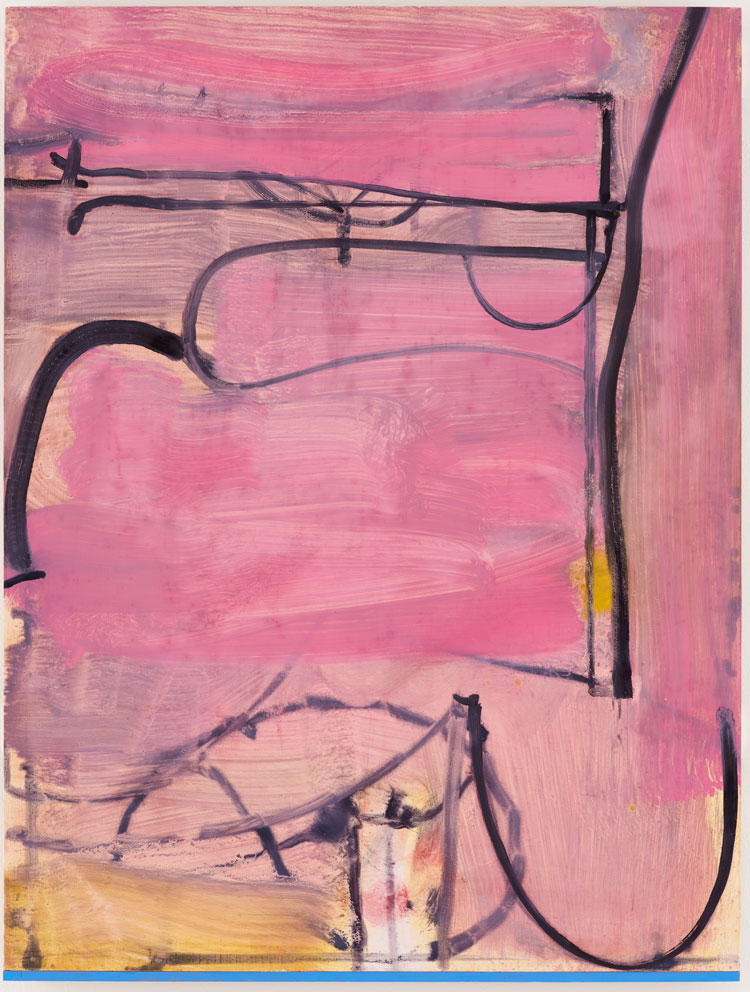
Matthew Burrows. Bather, 2019. Oil on board, 78.5 x 59.3 cm (30 7/8 x 23 3/8 in). © Matthew Burrows.
AMc: That makes sense. In fact, it’s almost contradictory listening to you, because you’re talking about keeping things simple, but obviously your thought processes are very complex. Your artist statement is quite poetic. You talk about finding your reality in the paradoxes and thresholds of the mystic’s landscape. Are you inspired by poetry and literature, as well by the landscapes themselves?
MB: Very much so. I think, in a way, painters are modern poets. In visual terms, they inhabit many of the same problems that contemporary poetry faces. People like the idea of it, but they’re not really interested in it. Sometimes painters find themselves in that situation, where there is a kind of poetic language, which, for a lot of people, seems really opaque and difficult, and yet, the paradox is, it is very straightforward.
The thing that’s great about painting, and the reason I have carried on doing it and love it so much, is that it is a way of thinking about and looking at the world where its only limitation is our imagination. As a medium, it’s infinitely flexible. It will do what your imagination asks of it, and if there are any failings, it’s not a failing of the medium, it’s a failing of your imagination. It calls you, the artist, to attention. There’s nowhere to hide in it.
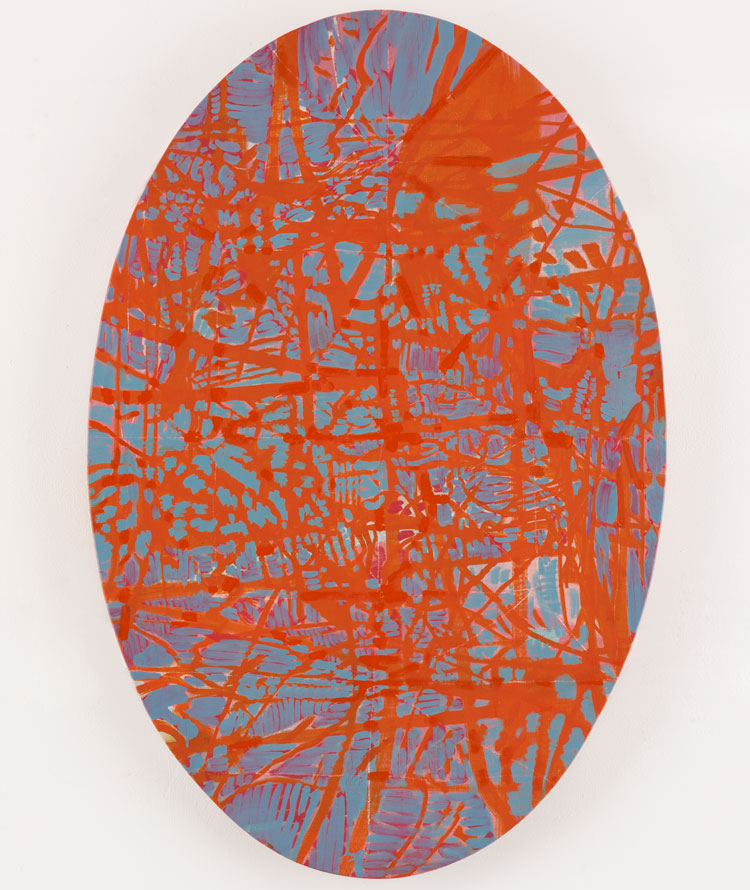
Matthew Burrows. Cardinal Points I, 2020. Oil on linen on board, 90 x 60 cm (35 1/2 x 23 1/2 in). © Matthew Burrows.
I should make clear, though, that my idea of a mystic is not this elusive, fantastical dreamer. I think mysticism is quite the opposite. I think mysticism is how we deal with reality and, when we deal with reality and attend to it wholly, completely, as a human being, in all of our senses – internally, externally – then it is a mystical experience. The ground is not mere matter and our ideas about it are not mere abstractions. Our relationship to nature is complicated and, much as we feel apart from it, we are it. I mean, we are nature, we are human nature. For me, one of the great problems with contemporary art is finding connectedness to our nature and to nature itself. It’s one of the things that we have removed ourselves from more and more as our culture has become more agrarian and industrialised. It’s problematic, not only personally as a human being, but also as a community, and also in terms of our relationship to the environment. It’s easy to abuse the environment if you don’t care for it, or if your care for it is only theoretical. Pre-agrarian, pre-industrial cultures understood this implicitly. I’m not pitching a regressive culture. What I’m suggesting, in a way, is that the great challenge, and what’s really exciting for me as an artist, is: how do we find a way, with the tools we now have at our disposal, to connect again? I asked that question of myself when I came up with #ArtistSupportPledge. That is what it’s based on: how do you quickly create connectivity in a way that matters, and which has a cultural identity that isn’t just an economic system but drives itself through its ethics? Embodied in that set of relationships are all our values. So, in a way, putting one colour next to another colour is a moral act. It’s not just beautiful visual aesthetics. Those aesthetics tell us something about what we think and feel as human beings, and that, in turn, tells us how we respond to ourselves, to each other, and to the world. For me, it’s all interconnected, and that is why I use the language of poetry and mysticism. The great mystics will talk about the simplicity of life, not about its complexity. It’s about where you stand. The ground at your feet is just as significant, just as beautiful, as it is anywhere else, and if we care for that, and our relationship to it, then our relationship to our environment changes, our relationship to ourselves changes, our relationship to our community changes, and our relationship to things like putting colour, lines, shapes and textures on to a surface changes. Maybe it’s stretching the definition of poetry, but, as an artist, I try to elude definition.
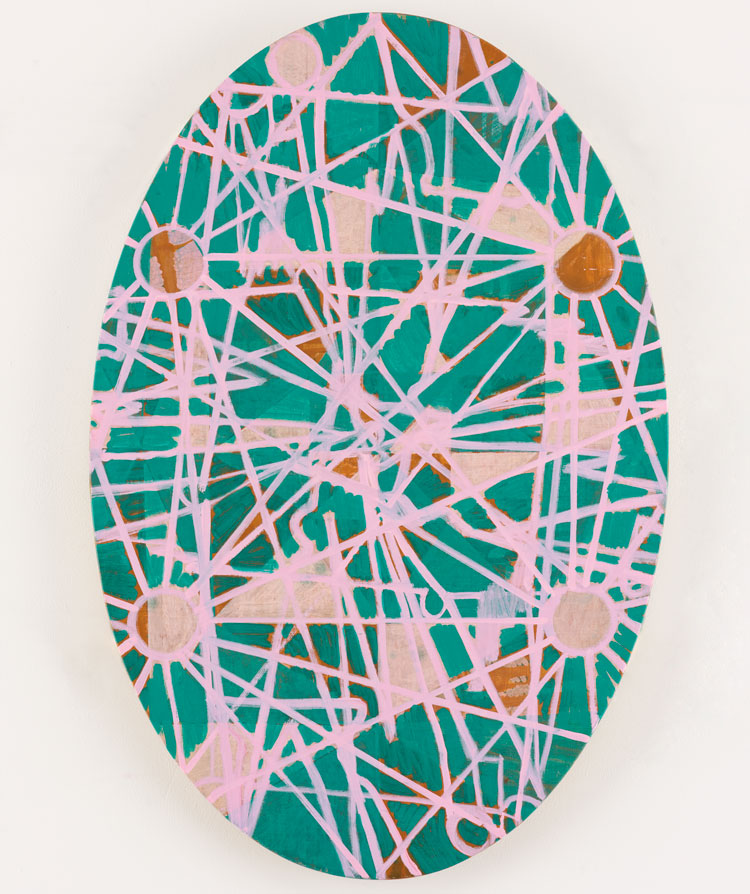
Matthew Burrows. Cardinal Points II, 2020. Oil on linen on board, 90 x 60 cm (35 1/2 x 23 1/2 in). © Matthew Burrows.
AMc: Tell me about the process of making a work. How do you get from all these thoughts – or “unthoughts” – in your head, from your inspiration, to the finished oil on board or linen? What is your starting point?
MB: The better way to think of it is the other way around. It’s not the starting point, it’s the endpoint. The way I see it, they’re not thoughts that I have to make the painting. The thoughts I have are reflections during the process, reflecting on what I’ve made. The act of making the painting itself is a thought and a relationship. I don’t prethink that. I don’t think: “I’m going to make a painting about X, Y and Z, and I’m going to make it like this.” I have approaches to subject matter, and to forms and materials, and I build that relationship, and then, within that, there are moments of reflection when I think: “OK, that’s like my relationship to the wind or to heat or to space,” and I don’t overthink it. It might sound like I do, but, when I’m making the work, I don’t at all. I try not to think in words when I’m making paintings, because words give you definitions.
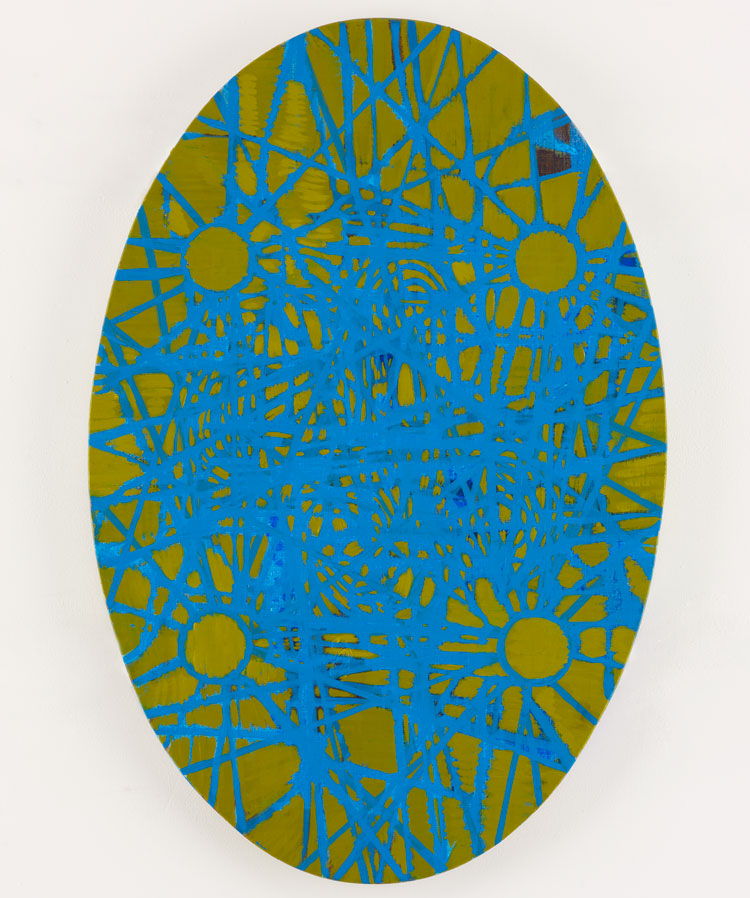
Matthew Burrows. Cardinal Points III, 2020. Oil on linen on board, 90 x 60 cm (35 1/2 x 23 1/2 in). © Matthew Burrows.
There are a few things I do first as preparation. I draw a lot from life, so I might just go wandering in the landscape, drawing in my sketchbook. There are themes and structures that I’m interested in, which I’ve been developing over the years. I make studio drawings, where I bring ideas together, which are rooted in my experience of landscape, and of embodiment in the landscape, but they don’t necessarily look like it. I might use the drawings I make in the sketchbooks to develop themes and motifs and spatial structures. It’s a very traditional approach to making images, forms and structures, which is repeated many times. I might spend some time, a couple of weeks, just making the drawings, to get really in depth and to build enough structure and motifs to work with. Then I might start making paintings intensively for two or three weeks, and then I might dip in and out of making the drawings again. I find that, normally, after a few weeks of intensive painting, it starts to slow down a bit. You start losing momentum, because you’re not feeding it with new ideas. That’s when I tend to go back to drawing or go to see other artists’ work. The best I can do is have a strategy for navigation; a strategy for how to approach my day in the studio and my working process. I do a lot of endurance running as a pastime, too. I run every day, and I have learned that you can draw energy from that relationship to the ground as you move over it. It becomes a reciprocal relationship. I try to do the same sort of thing with painting; find that reciprocal relationship. If you’re running through a landscape, you have to find your way. That’s where navigation comes in. When you set out, you don’t necessarily know where you’re going, but you can have skills in navigation, and they are your strategies of approach. You can know where north, south, east and west are, and you can know how to take bearings. I approach painting like that. I have developed tools of navigation, if you like, and then I go to sea and see where they take me.
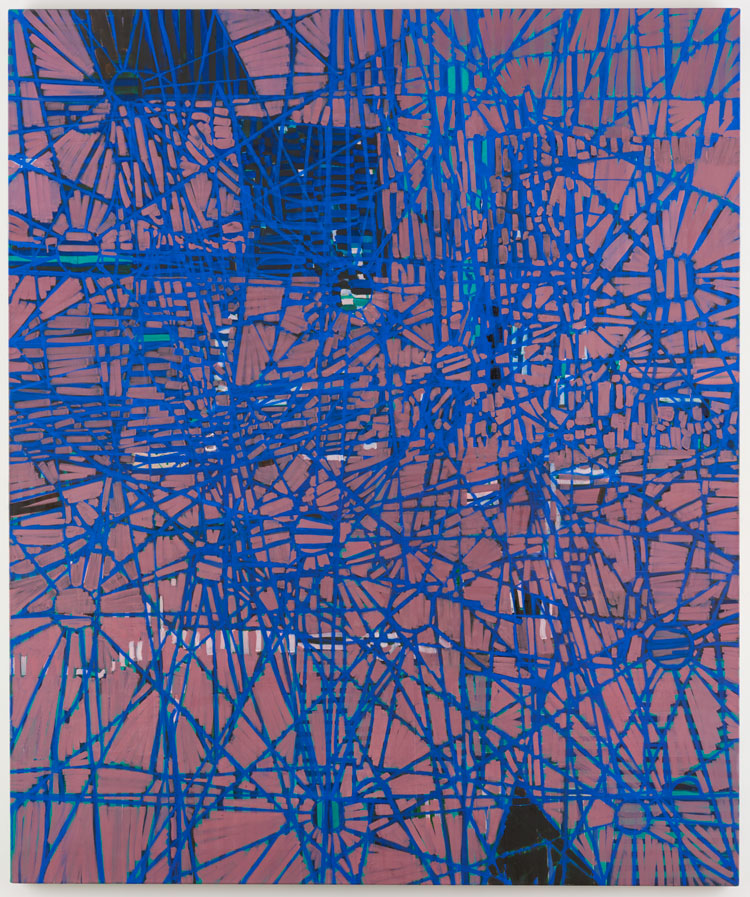
Matthew Burrows. Compass, 2019. Oil on linen, 180 x 150 cm (71 x 59 in). © Matthew Burrows.
AMc: It feels as if you are navigating not just horizontally, superficially across the surface, but, looking at your works, vertically, depth-wise, as well.
MB: That’s a good observation. It’s one of the things I have thought a lot about over the last 20 to 30 years, the relationship between the vertical and the horizontal in painting, and I could never really get a good understanding of what that dynamic was. It used to frustrate me, but I knew it was necessary, because it used to come back over and over again as a motif and structure in my painting. Then I read something a couple of years ago about the way that priests and shamans, prophets, work with the vertical and the horizontal. The priestly domain is the domain of ritual and tradition; it is repeated and is structurally complete. The idea is that they don’t deviate, the ritual is always the same. But the shamans or the prophets move horizontally across the surface, in and out of realities. Their movement is much more fluid and less restricted. I really liked that idea as an analogy for thinking about painting, which has both a structure that is given – the ritual of the painting, if you like; the structure in it that holds it together, like a scaffold – and the process of painting, which is like the movement in and out of other realities. Again, it’s a strategy for being able to engage emotionally and structurally in painting without getting lost in it. If I don’t have that, I either end up with a painting that’s too structured, too bland to look at, or with a painting that’s chaotic because emotionally it’s all over the place and can’t stabilise itself. I like that idea that the vertical and the horizontal give you a play between something that is given and something that is open.
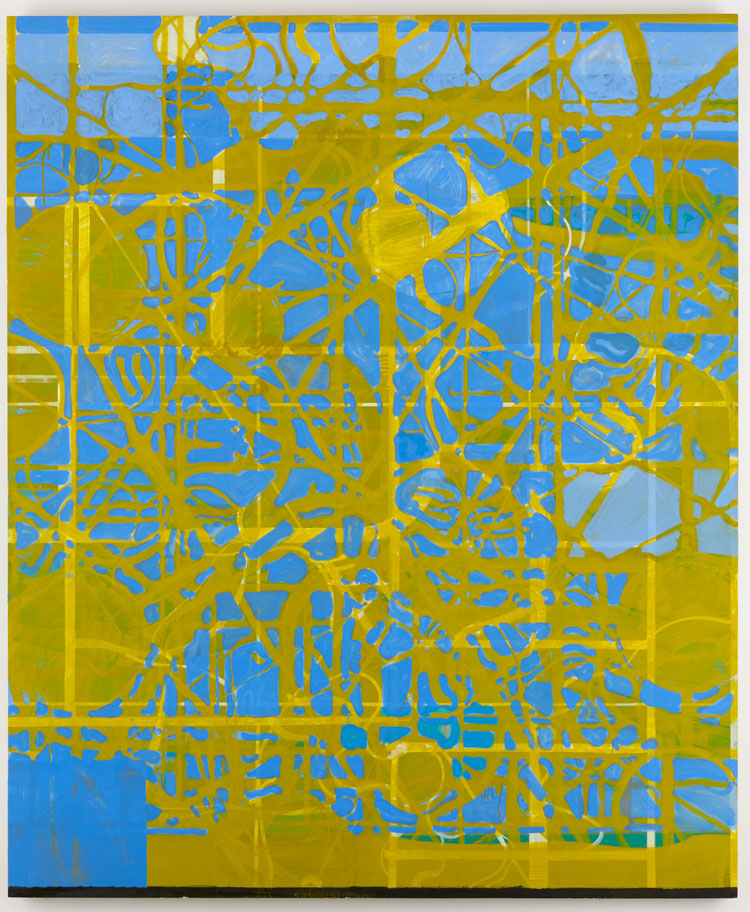
Matthew Burrows. Gatescape I, 2020. Oil on linen 240 x 180 cm (94 1/2 x 71 in). © Matthew Burrows.
AMc: That tallies with your basket weaving idea as well – the going in and out; under and over …
MB: True, I hadn’t thought about that, but you’re right.
AMc: How important is texture in your work, because it sounds as if there’s a lot of working into the surface?
MB: Yes, definitely. Surface is very important. I’d say there are three things that I really dwell on an awful lot in my work: the layering of images, structures and colours; trying to find that elusive enigma; and the tactile surface, how it feels to touch. Touch is really important to me because it’s one of the ways that we understand empathy. That’s why children like to touch things. When you say: “Have a look at this,” they’ll automatically go to take it from you and touch it. I like to think that is what I’m playing with, that sense of how to get your viewer to empathise with the painting through a sense of touch. In my work, I often do that through very thin layers of paint, so that it looks textured, but, when you see the painting up close, the layers are just creating an illusion of roughness, because they’re actually very delicate. So, there’s this odd paradox going on, between the delicacy of the layers and the loose, open, almost textural qualities of the work.
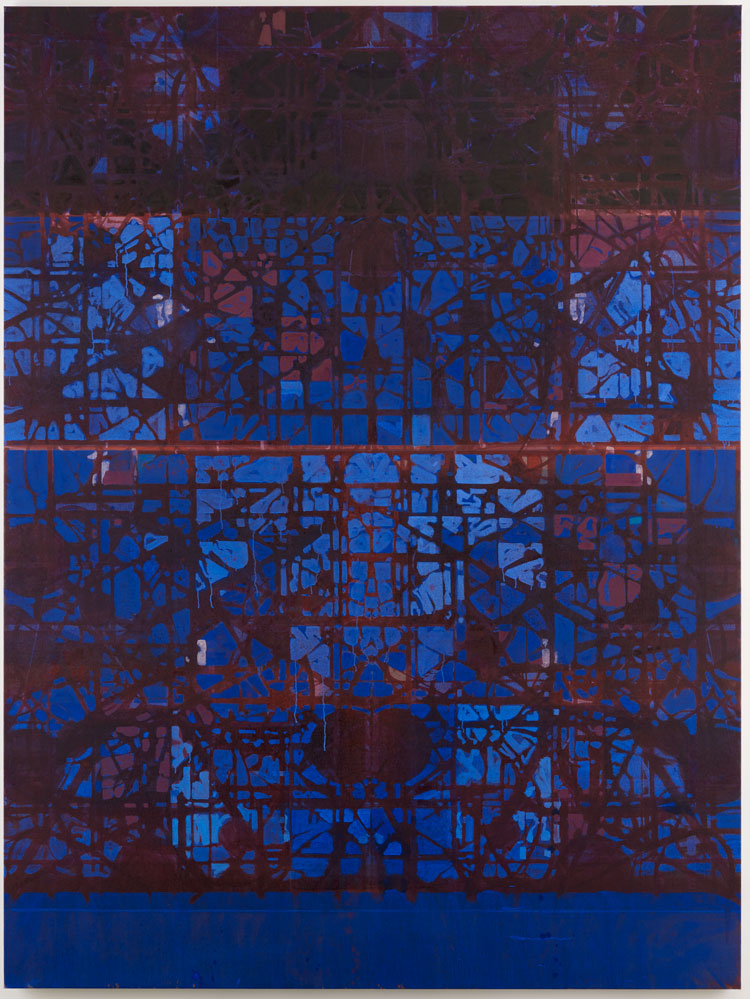
Matthew Burrows. Gatescape III, 2020. Oil on linen, 240 x 180 cm (94 1/2 x 71). © Matthew Burrows.
AMc: You mentioned stained glass earlier as well, and when I first looked at Gateway III (2020), I thought I was looking at a stained-glass window. In fact, I’m still looking at the jpeg now, and it’s almost translucent.
MB: I came up with that idea a few years ago now, when I was walking past a church and looking in through the stained-glass windows. When you see them in reverse, and there is no light behind, you become aware of the leaded structure, but you’re still also aware of the colour of the glass. It’s just not fully lit. I thought that was a really nice way of thinking about painting, too. That the colour is always there, it’s built into the thing itself, and all you’re doing as a painter is releasing that relationship. I use the stained-glass window analogy quite a lot in my own thought patterns. It’s that relationship between a structure and an experience of colour and form and space again. In a lot of stained-glass windows, the leading breaks the forms. It doesn’t necessarily go around them, sometimes it goes through them. The illusion is always incomplete, and you always have to come back to the fact that this is just a thing with light passing through it. It’s not really an image, it’s a thing as well.
AMc: Did your artist-in-residence scheme at Gloucester Cathedral (1999-2000) influence your ideas on windows?
MB: I guess it must have done. Certainly one of the windows there, in the lady chapel, was an influence, because it had been shattered and reconstructed. It’s a bit all over the place. The images don’t make sense, there are bits missing, there are bits that have been added. It’s fragmented, almost like a cubist painting. I’ll always remember looking at that when I was in residence there. It’s so like the way I think about painting: that you’re always moving in and out, trying to seek something, but never really seeing it complete. And, if you do see it complete, it somehow doesn’t feel as exciting. That’s the way I think about the landscape as well. When you occupy a landscape, you are part of it, but you’re just a tiny little part of it. You can only really grasp that little bit that you’re in; your microclimate. But that’s part of a much bigger picture, and you’re still part of that too. When I go for my long runs, I think of it as an extension of my work as an artist. It’s like drawing a very long line with my feet, and then that long line takes me on a journey into space, into the landscape and into the wilderness. A lot of my work, although it’s not based on them, is very much influenced by experiences I’ve had on those runs. It’s almost like rewilding my own nature. Exploring the wilderness out there in the world is a way of exploring my own wilderness. What I’m trying to do, when I’m making a painting, is find a way of connecting those two. I think that’s what all great painting does, whether it’s a Rothko, a cave painting, or a Rembrandt. They find a way of connecting natures so that they become complete.
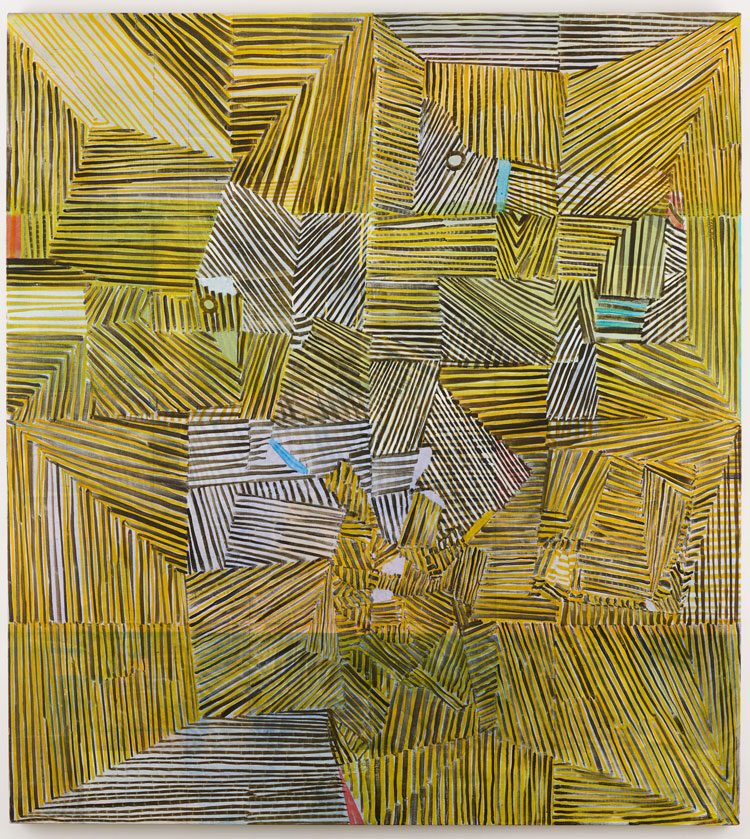
Matthew Burrows. Sternō, 2020. Oil on linen, 200 x 180 cm (78 3/4 x 71). © Matthew Burrows.
I talk about my painting in bigger-picture ideas, not because I want it to be philosophical or political, I don’t. That’s not what my agenda is. But what I have realised is that even making a line on a piece of paper has much bigger implications than the mere line on the paper. It is an expression of all our relationships and values.
AMc: That leads me in quite nicely to asking about the bigger picture beyond your practice. Before we come to #ArtistSupportPledge, for a good many years you have also been running a mentoring scheme – Artist Support Projects – alongside your practice. Why is it so important to you to help and support others in this way?
MB: I set up the scheme 12 years ago now, initially just to help some friends and colleagues navigate being professional artists. I think a lot of artists suffer because they end up being quite isolated intellectually, emotionally and artistically. So, I came up with a process for developing small groups of people – sometimes just three or four in a group – which could sustain one another. I thought that if we could develop a culture within each of those groups that was about supporting one another, and supporting the immediate culture around them, then this would create an energy and a capital of its own. I’ve been working with this idea of generating a culture of trust and generosity now for 12 years, and when I was coming up with the idea for #ArtistSupportPledge, those were the foundations I used. I thought: “OK, I’ve got this culture of fostering generosity, and I’ve got this network of artists who are ready to act.” Once I had the idea, I began to put it out there, and I rallied everybody and asked them to get involved and tell everyone else. That’s basically how it worked. It’s just a movement with a code of conduct and a moral contract, which is how most cultures survived for thousands of years before we ended up with the one we’ve got now, which is very legally based. If you tell someone to do something, they’ll do it, but they’ll do it slowly. But if you make somebody want to do something, they’ll do it quickly and with a level of engagement or focus that they wouldn’t have otherwise. So, by coming up with a process that replicated the networks and the culture of Artist Support Projects, I figured it would at least get somewhere. I didn’t, of course, imagine quite how successful it would become.
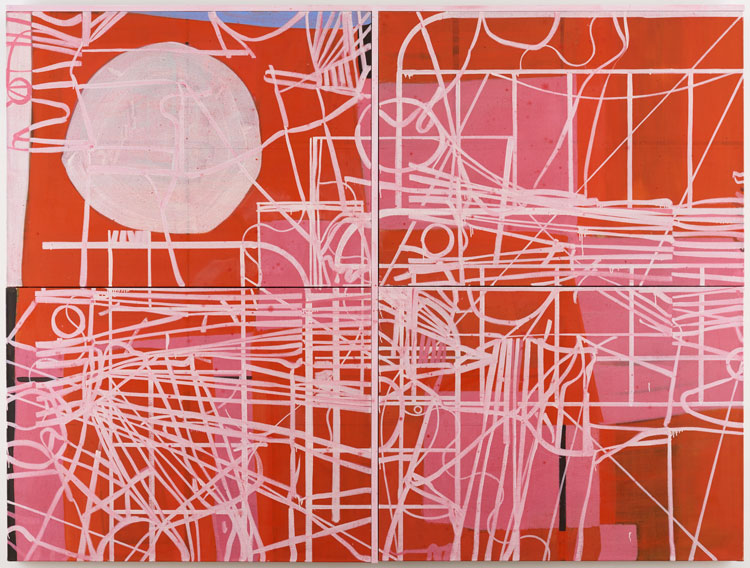
Matthew Burrows. Sleepscape, 2019. Oil on linen 182 x 242 cm (71 5/8 x 95 1/4). © Matthew Burrows.
AMc: The initial idea was around the time that lockdown started, wasn’t it?
MB: It was a a week before; 16 March. It was that period when a lot of people had been told not to go to work. I found myself sitting here answering endless emails from people who were saying, “This project’s ending,” “I can’t come and do this now,” “We can’t do that show any more,” that kind of thing. At the same time, I noticed my phone kept pinging, and all the messages were the same. Again, “My show’s been cancelled,” “I’ve been told not to come to work tomorrow,” or “All my teaching’s stopped.” For artists, that’s really bad, because they don’t have any other income, and if there’s even a three-month period with no income, that is going to be tough. It was a desperate moment, where I thought to myself: “I’ve got to do something.” I asked myself what my assets were, and I wrote down “culture of trust and generosity, and artwork”. They’re the two things that I’ve got right now. Then it was really about trying to find a way of making that work as a formula. We only started selling art in the 1700s. It’s a very recent phenomenon. For thousands of years, artists have had a relationship to the world, to its economies and to culture that wasn’t about galleries and art fairs. I make art and sell it. But it never really felt right. It always seems that you’re not really engaged in your community in any way – with a small C and a large C. I had been playing with this idea of whether we could create a subsistence culture for art, but I didn’t really have any great plans. Then this came around and that’s the model I used. I thought about hunter-gatherer societies, and how they work by codes of conduct, whereby everyone has an equal say, and everyone has the right to food. That was the formula I used: no one can charge more than £200, and everyone is implicitly obliged to support one another and buy someone else’s work, once they have sold £1,000 worth of their own. In hunter-gatherer societies, when somebody gets the kill on the hunt, they have the honour of dividing the meat and handing it out among their closest friends and family, and then their closest friends and family have the obligation to divide that meat again and hand it on to their closest friends and family. The meat crosses the community and everyone gets fed. If anyone, for some reason, doesn’t get fed, all they have to do is go to the campfire and, if somebody else has food, it’s their obligation to feed them, whether they were involved in the hunt or not. I like the idea that if all of us, as artists, implicitly support one another by handing on what we have, by handing on a bit of our meat, then everyone will get fed. And I couldn’t, in my wildest dreams, have imagined it would grow at the rate it did and be as successful as it has been. I don’t think anyone would have thought that, no matter how smart the idea might have sounded. I have to admit, when I came up with it, it didn’t sound that great, but it was the best I could come up with on the day, and so I lived with it for the day, kept playing with it, and then I asked my family what they thought. They didn’t really say very much, but they didn’t wince too much either, so I thought it must be all right, and then I just posted my image online on my Instagram account that evening, while watching TV, and it went from there. Within 24 hours, it was across the world. The speed of it was unbelievable.

Matthew Burrows. Drawing included on #ArtistSupportPledge, from the In and Through Series, 2020. Ink on handmade paper, 26 x 21 cm. © Matthew Burrows.
AMc: It really is a simple idea. I’m sure that helps. As you have said, you sell a work for £200 or less, on the understanding that once you have sold £1,000 worth, you are obliged to buy something from someone else. And you put it on Instagram and use the hashtag #ArtistSupportPledge. In the meantime, it has spread to Facebook and Twitter as well. Within the first month, there was an estimated £15m worth of sales, and it has been a good couple of months now. Do you have any idea of what the turnover currently stands at?
MB: I dread to look at the figures. I have someone who does the economic modelling for me, because I have no idea about that kind of thing. It’s quite complicated, the economics of it. We’ve simplified it as much as possible, but one post can be worth anywhere between £20 and £20,000, depending on what it is – whether it’s a print in an edition, how many editions there are, that kind of thing. I actually dread to think what it is now. I’ve given up worrying about it, to be honest, because it almost doesn’t matter. I get hundreds of messages a day from people all over the world saying that they’re making a living out of it, and that is what matters. Most of my friends are making a living out of it, and the irony of it is that most of them are making more money doing this than they have ever made in the mainstream art market. It is mindboggling, really, because this was just meant to help people survive. But a lot of people are earning in a week what they used to earn in a month. We worked out the upper limit, and it’s unlikely someone could earn more than about £140,000 a year, allowing for them to keep up with making the work. Even if you get halfway to that limit, you’re likely to be selling out everything that goes on the pledge. What happens then is that you’re not only donating your 20% back into the system, but you’re spreading the economy across the system. Buyers are spreading their finance across the system, too, because they’re then having to buy elsewhere. It creates what I call a horizontal economy, where the money comes in and is pushed across, rather than going up. In our normal art market, the money goes up the market, and the figures get bigger towards the top, but the amount of people who benefit gets smaller. With this, you can’t actually get that high. At a certain point, the money just gets pushed sideways, and it starts to cover the network, so more people make money. Again, it’s not foolproof, so there will still be some people who don’t sell anything. At the end of the day, it is a market, and you have to have goods that somebody wants to buy.
I’ve tried not to introduce any barriers, though. I’ve included makers, not just artists. If this is an egalitarian economy, if this is about embracing a generous culture, I’m not in the game of saying: “You can’t join because you’re not like me.” I didn’t want any hierarchy. I wanted to say yes to as many as I could. We have potters and cushion-makers. There are limits, though, and I couldn’t find a way of including writers and musicians that didn’t compromise things. So, I have kept it to artists and makers, and we’ve got #ArtistSupportPledge framers as well. It has stayed within the realms of people who make things visually.
AMc: You are now also working with the Crafts Council, which is using its networks to help establish a campaign press office and provide administrative support.
MB: Yes, it has been really great at bringing the makers to the platform and getting the message out there that it’s open to them, too. It has been managing that extra workload for me, using its PR systems. I’m busy at the moment trying to establish #ArtistSupportPledge as something more permanent, because even if I decided to stop tomorrow, it wouldn’t just stop. I think of it as a bit like having a child that you have to let have free rein, occasionally, but you’ve also got to nurture it because it’s not a system yet. It is a culture, and a culture needs nurturing. You need to keep the message clear and keep that going out there. But I’m in the process of setting up the structure that will keep going into the future, developing new partnerships and collaborations with other organisations, who can support it.
AMc: I am sure you will be glad to have some of the onus taken off you, so you can get back to making your own work as well.
MB: Yes, my plan over the next few weeks, months, or so, is to go back to being a full-time painter. But it’s clear to me that I’m never going to be able to shake #ArtistsSupportPledge. What I need to do is find an efficient way of dealing with it, and a way where I can then employ people to do the bits that I’m currently doing. I need to monetise it in a way that is effective and appropriate. It’s been a huge privilege to do it, and I’m not begrudging of the workload. But, obviously, I want to go back to doing what I do.
AMc: How do you see the long-term impact of the pandemic on the art market in general? Also, you have been selling work through the pledge, but you are represented by Vigo Gallery, and your works would normally sell for a lot more than £200 each. Are you worried about your pledge sales having an impact on your longstanding value?
MB: I thought a lot about that before I did it. I have been speaking to Vigo Gallery about a strategy for how to deal with it, how to not completely undermine my market, but, also, to not undermine the pledge, because that needs to have its own integrity. I purposely designed the pledge so that products that never really find their way into the mainstream market can be sold there. Drawings, for example, at £20 or £30. Most galleries don’t touch drawings, and don’t touch prints at that level, because there’s just not enough profit in it. Artists’ studios are filled with them. I’ve got thousands of drawings in my studio that I’ve made over the decades, and I’ll never show them because no gallery will ever sell them. It takes the same amount of admin to process a drawing as it does to process a £20,000 painting. There is a level of flexibility with #ArtistSupportPledge. If you’re an artist who doesn’t have a market already, you might be putting one-off paintings on there for £200, and that might be your upper limit at the moment. It might be as much as you can charge, but, as you become more successful, and you can charge more for your paintings, then maybe you can then start putting drawings or prints or reproductions on the pledge. If you are an artist who ends up in the situation where a drawing is selling for £30,000, then, frankly, you don’t need #ArtistSupportPledge.
AMc: No. Well, I really hope you can find the time to get back to your own work at some point soon.
MB: I’ve been working today. I’ve been trying to give myself a day each week where I just make work, and then I do a little bit each day as well, in between emails and press interviews. In the evening, I catch up on admin and stuff like that. I can get two or three hours of painting in a day at the moment. And that’s good.